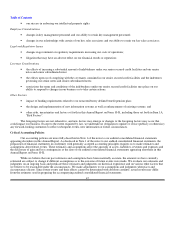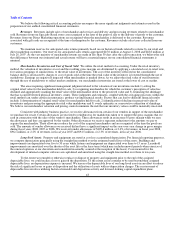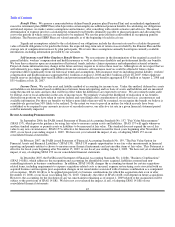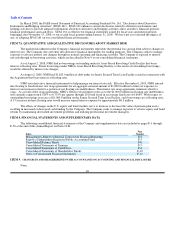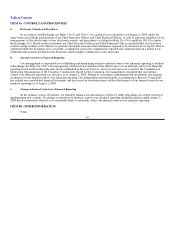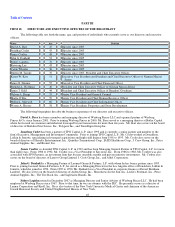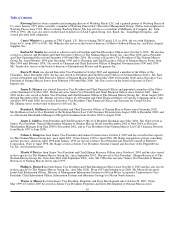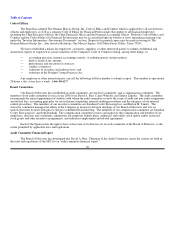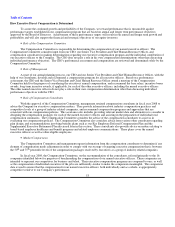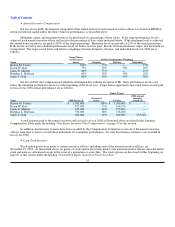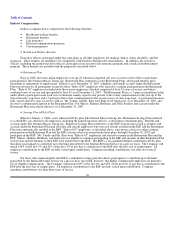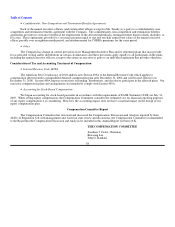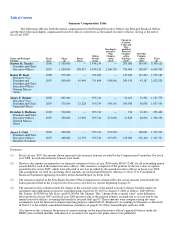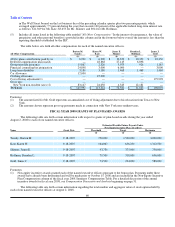Neiman Marcus 2007 Annual Report Download - page 55
Download and view the complete annual report
Please find page 55 of the 2007 Neiman Marcus annual report below. You can navigate through the pages in the report by either clicking on the pages listed below, or by using the keyword search tool below to find specific information within the annual report.
Table of Contents
ITEM 11. EXECUTIVE COMPENSATION
Compensation Committee Interlocks and Insider Participation
In fiscal year 2008, Jonathan Coslet, Kewsong Lee, and John G. Danhakl served as members of our Compensation
Committee. No officer or employee served on the compensation committee (or equivalent), or the board of directors, of another entity
whose executive officer(s) served on our Compensation Committee or Board.
Compensation Discussion and Analysis
Overview
• Compensation Philosophy and Objectives
We are a premier luxury retailer that has been in business over 100 years. Our continued success depends on the skills of
talented leaders who are dedicated to achieving solid financial performance, providing outstanding service to customers, and
managing the Company's assets wisely. Our compensation program is designed to meet the following objectives:
1. To recruit and retain executives who possess the exceptional ability, experience, and vision to sustain and promote our
preeminence in the marketplace.
2. To encourage and reward the achievement of our short- and long-term goals and operating plans.
3. To encourage and reward increasing customer satisfaction, improving customer service, providing our customers with
the high-end luxury merchandise they have come to expect, and increasing the amount of business our customers do with
us.
4. To align the interests of our executives with the financial and strategic objectives of our equity investors.
5. To provide total compensation opportunities that meet the expectations of a highly skilled executive team, are aligned
and consistent with our fundamental performance and are competitive with the compensation practices and levels offered
by companies with whom we compete for talent.
Elements of Direct Compensation
The following are the primary direct and indirect compensation elements that make up our executive compensation program:
The three primary forms of direct compensation we provide are:
• Base salary
• Annual Bonus
• Long-term incentive through an initial stock option awarded in fiscal year 2006 and a cash incentive plan.
The discussion and analysis below is focused primarily on these elements.
• Base Salary
Base salary is intended to provide a base level of compensation commensurate with an executive's job title, role, tenure, and
experience. We utilize base salary as a building block of our compensation program, establishing a salary range for particular
positions based on survey data and job responsibilities. Being competitive in base salary is a minimum requirement to recruit and
retain skilled executives. Specifically, base salary levels of the named executive officers are determined based on a combination of
factors, including our compensation philosophy, market compensation data, competition for key executive talent, the named executive
officer's experience, leadership, achievement of specified business objectives, individual performance, our overall budget for merit
increases, and attainment of our financial goals. Salaries are reviewed before the end of each fiscal year as part of our performance
and compensation review process as well as at other times to recognize a promotion or change in job responsibilities. Merit increases
are usually awarded to the named executive officers in the same percentage range as all employees and are based on overall
performance and competitive market data except in those situations where individual performance and other factors justify awarding
increases above or below this range. Merit increases typically range between two and eight percent. See discussion on "Base Salary"
on page 54 of this section.
51



